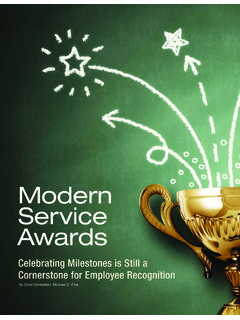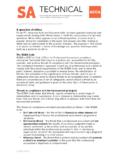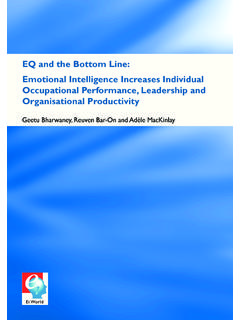Transcription of Market Brief Recognition PRogRams
1 BriefMarket BriefRecognition PRogRams :The BesT PrescriPTion for healThcare organizaTionsRECOGNITION PRogRams : ThE BEST PRESCRIPTION FOR hEALThCARE ORGANIZATIONSWith enormous pressure on hospital managers to meet threadbare budgets while refocusing operations on increasing quality of care, many healthcare organizations are refreshing their existing reward and Recognition PRogRams to drive employee engagement, reduce voluntary nursing staff turnover, and place greater emphasis on performance metrics linked to the Affordable Care LESS WITh LESSEver since the Affordable Care Act (ACA) began tying Medicare payments to individual hospital performance in 2012, the healthcare industry has been grappling with providing a higher quality of patient care amid historically low operating budgets and rising costs.
2 More and more, standalone hospitals are joining larger healthcare networks to stay afloat and ensure Market relevance 2013 alone saw the creation of the four largest healthcare systems in the country thanks to mergers and acquisitions. Healthcare networks are increasingly relying on private practices to partner with them in non-ownership collaborations, allowing local practitioners to help stem the tide of incoming patients. Nearly two-thirds of doctors in America are now under the umbrella of a larger health network, a 70 percent increase over the last three healthcare systems consolidate into these broader decentralized networks, the workforce becomes spread out and there are fewer decision-makers when it comes to budgets, posing a challenge to HR departments and hospital managers trying to increase quality of care within their departments while containing costs in other words, doing less with : hIGh TURNOVER, hIGh DEMANDN urses arguably exert the highest amount of impact on a patient s perception of care, but hospitals are facing a considerable human capital challenge.
3 The average American hospital is cutting 25-40 percent of their operating expenses over the next five years2 to survive, and staff levels are bearing the brunt of those cuts. Complicating matters, the need for registered nurses will grow 19 percent from 2012 to 2022, faster than the average for all The shortage of nurses remains a major concern worldwide because of its influence on the efficiency and effectiveness of healthcare delivery point to inordinately high turnover rates as the reason for the shortage. It has been reported that 13 percent of new nurses consider leaving their jobs within one year, a strong contributor to nurse dissatisfaction. Other popular reasons for job dissatisfaction among nurses are excessive workload, not being recognized and valued for their contributions, and lack of supervisor The situation is so grim that hospital administrators are no longer concerned with keeping an even staff-to-bed ratio, instead focusing on their Full Time Equivalent (FTE), or the overall efficiency they get from their current understaffed OF RECOGNITIONBy now, most healthcare administrators are already aware that achievement-based Recognition initiatives ( rewards tied to positive behaviors and performance metrics)
4 Can increase engagement and have tangible effects on patient perception of care outcomes, which is why most hospitals already have these PRogRams in place. What hospitals are doing differently is reexamining these PRogRams and trying more targeted methods of increasing productivity, in some cases expanding them to reach more employees. 2012 2017 2022 NURSE ShORTAGE19% INCREASE IN ThE NEED FOR NURSESMEANWhILE13% OF NEW NURSES CONSIDER LEAVING WIThIN A yEARSATISFACTION DECREASESE xcessive PaperworkNo AppreciationLack of SupportconTriBuTors To DissaTisfacTion: Hospitals are figuring out, not only is there an opportunity to not lose money on value-based purchasing, Bob Murphy from the healthcare performance improvement firm Studer Group explains, but some of them could make a lot more.
5 Now in its second year, the ACA s HCAHPS surveys (which grade hospitals on the patients perception of care and ultimately decide how much funding a hospital receives) Sources: US Bureau of Labor Statistics; Journal of Nursing Scholarship hOSPITALS ARE FIGURING OUT, NOT ONLy IS ThERE AN OPPORTUNITy TO NOT LOSE MONEy ON VALUE-BASED PURChASING, BUT SOME OF ThEM COULD MAkE A LOT MORE. Bob Murphy, Studer Group092320141,2, Murphy, Bob. Studer Group Presentation. Keynote Speech, Midyear Event from Michael C. Fina Corporate Sales, New York, July 18th, Bureau of Labor Statistics. Registered Nurses: Occupational Outlook Handbook. Bureau of Labor Statistics. #tab-6 (accessed August 4, 2014).
6 4 Atefi, N., Abdullah, Wong, and R. Mazlom. Factors influencing registered nurses perception of their overall job satisfaction: a qualitative study. International Nursing Review: Kovner, C., C. Brewer, Wu, Y. Cheng, and M. Suzuki. Factors associated with work satisfaction of registered nurses. Journal of Nursing Scholarship 38: Michael C. Fina. Gem Program Improves Transport Performance at Staten Island University Hospital. Case Study. (accessed August 4, 2014).7 Murphy, Bob. Studer Group Presentation. Keynote Speech, Midyear Event from Michael C. Fina Corporate Sales, New York, July 18th, generated a trove of publicly available performance data, and as administrators learn what their individual strengths and weaknesses are, they are making more strategic decisions within their Recognition PRogRams to increase efficiency at a minimal cost.
7 One such hospital was Staten Island University Hospital (SIUH), part of the North Shore-LIJ Healthcare System and subject of a recent Michael C. Fina case study: SIUH s radiology transport department was performing below the industry standard of patient moves per hour. They leveraged their parent health system s existing Recognition platform to create an award initiative related to the metric. Framing it as a friendly competition, the SIUH administrators encouraged their staff with small GEM (Go the Extra Mile) awards that had a nominal amount of redeemable award currency attached to them and could be handed out on the spot. The radiology team ended up surpassing the industry standard, setting a new record of patient moves per hour.
8 More patient moves per hour meant the hospital could handle more patients with the same amount of staff. It also meant patients were being moved through radiology faster, improving their perceived quality of care. Most important, the SIUH employees who participated were left feeling accomplished rather than SIUh - PATIENT MOVES PER hOURINCREASE EFFICIENCy WITh STRATEGyBy targeting specific metrics with Recognition initiatives, organizations can improve efficiency and job satisfaction piecemeal in a cost-effective manner. This Moneyball approach to increasing FTE is becoming the prevailing strategy for Recognition in hospitals. Achievement-based reward and Recognition PRogRams offer a creative solution to a more decentralized industry where individual employee performance is scrutinized as a benchmark for funding.
9 Recognition PRogRams will be leveraged to a greater extent starting in 2015, when the outlying clinical groups being acquired by large health networks begin their own version of mandatory quality of care surveys, or Healthcare organizations are making reward and Recognition PRogRams a strategic imperative, and rushing to repurpose them with heavy C-level involvement to increase efficiency as much as possible. Doing less with less just got a little PrograM resulTsSetting a Positive ToneIncreased CommunicationOne Dedicated and Focus GoalRESULTSINDUSTRy







